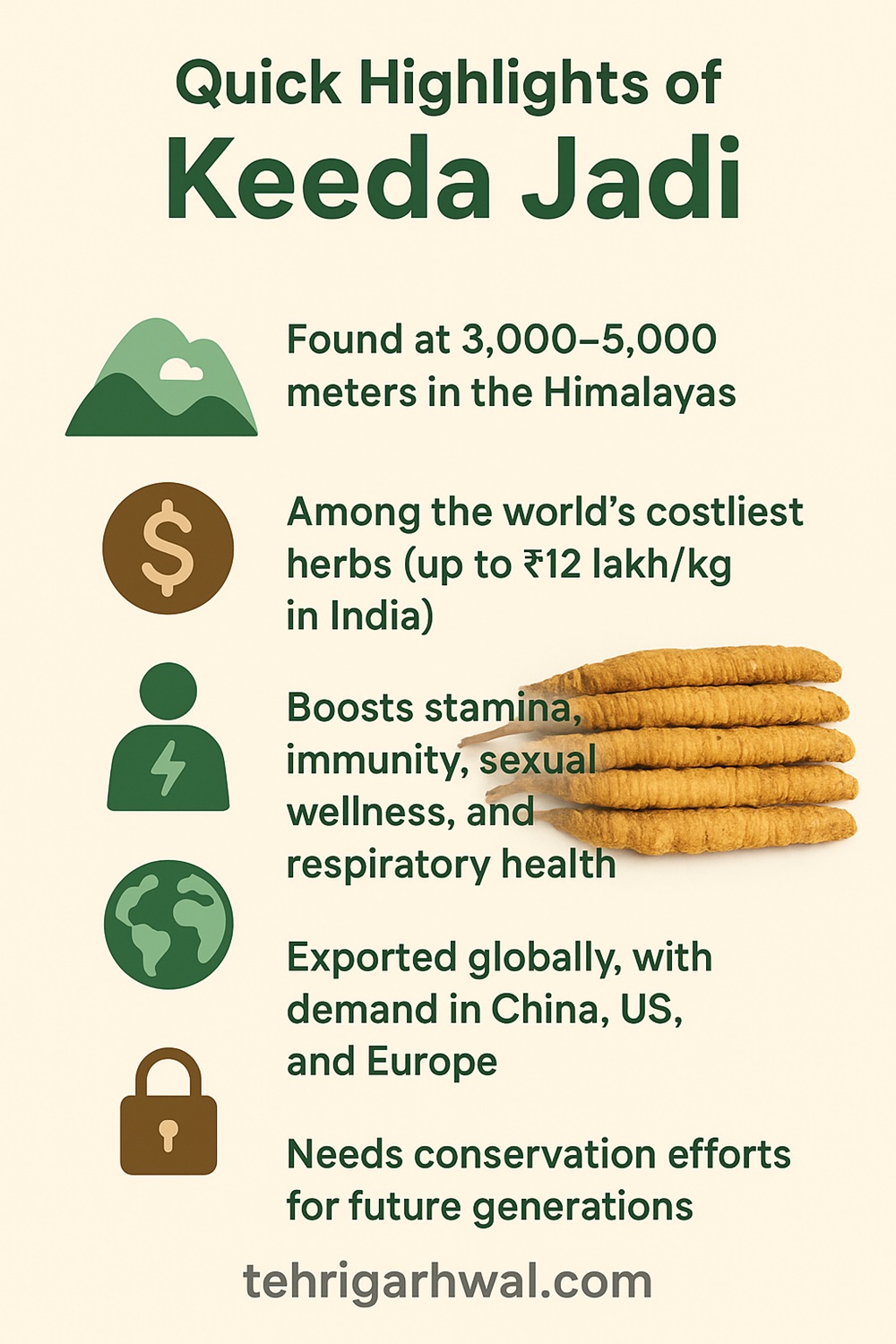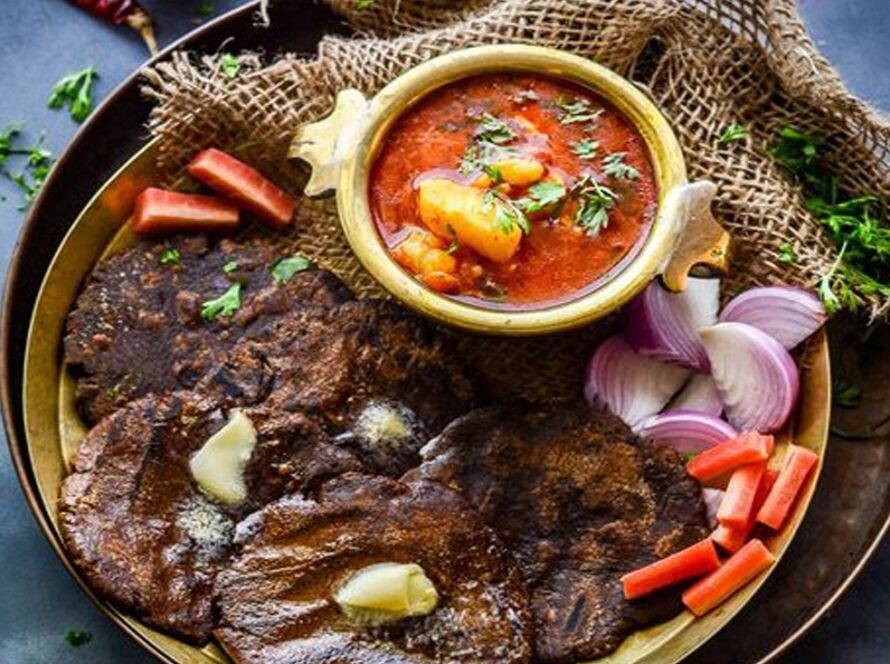Keeda Jadi, also known as Cordyceps Sinensis, is often called the Himalayan Gold because of its rarity, high value, and incredible medicinal properties. Found at altitudes between 3,000–5,000 meters in the Himalayan regions of Uttarakhand, Nepal, Bhutan, and Tibet, this unique parasitic fungus has been treasured for centuries in traditional medicine.
In India, especially in Uttarakhand, Keeda Jadi is considered one of the most sought-after natural herbs with both cultural and medicinal importance. Let’s explore its origins, benefits, uses, and why it commands such a high price worldwide.
What is Keeda Jadi (Cordyceps Sinensis)?
Keeda Jadi is not just an herb—it is a parasitic fungus that grows on caterpillars of ghost moths. The fungus attacks the insect larvae underground, slowly consuming it and eventually sprouting a thin stalk-like mushroom above the soil. This rare natural phenomenon is what makes Keeda Jadi so unique and precious.
🐛Local name: Keeda Jadi (literally meaning “insect herb”)
🔬Scientific name: Cordyceps Sinensis
🌿Common names: Himalayan Viagra, Yarsagumba, Himalayan Keeda Jadi
👁️Appearance: Resembles a dried caterpillar with a brown stalk-like structure
Health Benefits of Keeda Jadi
Traditional healers and modern researchers both recognize the potential of Keeda Jadi. It is believed to contain bioactive compounds like cordycepin, polysaccharides, and adenosine that promote overall health.
Key Benefits of Keeda Jadi:
-
Boosts Energy & Stamina
– Popular among athletes for increasing endurance and reducing fatigue. -
Enhances Immunity
– Supports the body’s defense system and fights infections. -
Improves Respiratory Health
– Traditionally used to ease asthma, bronchitis, and breathing issues. -
Supports Sexual Wellness
– Known as “Himalayan Viagra” for its role in improving stamina and libido. -
Anti-Aging Properties
– Rich in antioxidants that slow down cell damage. -
Regulates Blood Sugar
– Some studies suggest it may help in managing diabetes.

Uses of Keeda Jadi
Keeda Jadi is consumed in different forms depending on cultural practices and medicinal purposes.
Common Uses:
🪷Traditional Medicine: Used in Ayurveda, Tibetan, and Chinese medicine.
💊Supplements: Available as capsules, powders, or tonics.
🍵Tea/Infusion: Dried Keeda Jadi is steeped in hot water for daily wellness.
⚡Energy Booster: Athletes and mountaineers use it for stamina and endurance.
Keeda Jadi Price and Rarity
Keeda Jadi is often called the world’s most expensive herb. Its price depends on quality, demand, and origin.
-
Average price in India: ₹8–12 lakh per kg
-
International market: $20,000–40,000 per kg
-
Reason for high cost:
-
Found only at high Himalayan altitudes
-
Short harvesting season (May–July)
-
Extremely limited availability
-
Growing demand in global markets
-
Where is Keeda Jadi Found?
-
Uttarakhand (India): High-altitude regions of Chamoli, Pithoragarh, and Munsiyari
-
Nepal: Dolpa, Mustang, and high Himalayan belts
-
Bhutan & Tibet: Major exporters of Keeda Jadi worldwide
Challenges in Harvesting Keeda Jadi
The collection of Keeda Jadi is not easy. Local villagers trek for days to high-altitude pastures, risking health and safety.
Challenges faced:
-
Extreme cold and tough terrain
-
Risk of landslides and altitude sickness
-
Strict government regulations to control over-harvesting
-
Declining availability due to climate change and over-extraction
Keeda Jadi: Cultural and Economic Importance
For Himalayan communities, Keeda Jadi is not just medicine but also a major source of livelihood. Entire families engage in its collection during harvesting season, with earnings supporting their annual income.
-
Economic importance: Provides financial stability to remote mountain villages.
-
Cultural belief: Considered a natural gift of the Himalayas with healing powers.
Recent Developments & Government Measures
In recent years, the Uttarakhand forest department has intensified efforts to regulate the collection and trade of Keeda Jadi (Cordyceps Sinensis), ensuring that local communities benefit from this rare Himalayan resource. According to The Times of India, mapping exercises are being conducted across alpine meadows to identify high-yield areas. These measures not only help track harvesting patterns but also create opportunities for locals to receive fair prices while discouraging exploitation by middlemen.
Government bodies have also tightened rules for permit issuance and trade regulation, as highlighted by News9live. This step is crucial to curb illegal harvesting and smuggling, which threaten both the environment and the livelihoods of villagers who depend on the fungus.
Additionally, research initiatives reported by ETV Bharat have begun exploring the possibility of lab cultivation of Keeda Jadi. Scientific cultivation could reduce pressure on wild populations while ensuring sustainable availability for medicinal and commercial use. Together, these efforts mark a shift toward conservation-driven utilization of this valuable Himalayan herb.

How to Buy & Use Keeda Jadi Safely
Due to its high demand and premium price, Keeda Jadi is often subject to counterfeiting. Buyers should always check for authentic origin, purity, and certification (if available) before purchasing. Authentic Keeda Jadi generally comes from high-altitude Himalayan regions like Uttarakhand and Nepal.
In terms of usage, the fungus is available in dried form, powder, and capsules. Recommended dosage should always be taken under medical supervision, as excessive or unsupervised consumption may cause side effects.
Lastly, beware of fraudulent sellers. Experts advise purchasing only from trusted herbal stores, licensed dealers, or verified online platforms to ensure safety and authenticity.
FAQs
Q1. What is the harvesting season of Keeda Jadi?
It is usually harvested during May–June, when snow melts in high-altitude meadows.
Q2. How much does Keeda Jadi cost per kilogram?
Depending on quality, the price can range from ₹8–15 lakh per kg in India.
Q3. Is collecting Keeda Jadi legal in Uttarakhand?
Yes, but only with permits issued by the forest department. Unauthorized collection is illegal.
Q4. Can Keeda Jadi be cultivated in labs?
Yes, research is ongoing, and lab cultivation has shown early success in reducing dependence on wild stocks.
Q5. What health benefits are backed by science?
Studies suggest benefits for immunity, stamina, and respiratory health, but more clinical trials are needed for confirmation.
Final Thoughts
Keeda Jadi (Cordyceps Sinensis) stands at the intersection of nature, health, and livelihood. Its medicinal benefits, global demand, and Himalayan origin make it one of the most valuable herbs in the world. However, its rarity also highlights the need for sustainable harvesting and scientific cultivation to protect both the species and the communities dependent on it.
References:
https://pmc.ncbi.nlm.nih.gov/articles/PMC3121254/
https://www.ncbi.nlm.nih.gov/books/NBK92758/
https://timesofindia.indiatimes.com/city/dehradun/no-policy-in-place-illegal-trade-of-keeda-jadi-continues-unabated/articleshow/60380136.cms


